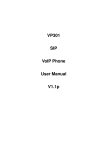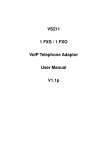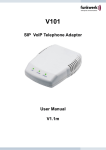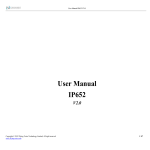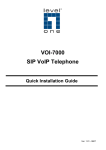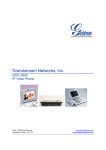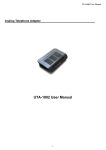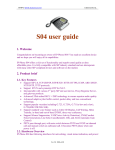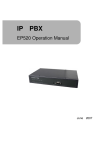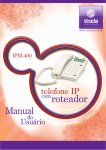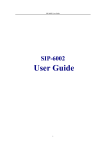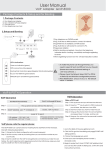Download User Manual - Billiger.de
Transcript
VOI-7000 VOI-7100 SIP IP Telephone User Manual 1 Ver 2.01 - 0609 Table of Contents 1. 2. 3. INTRODUCTIONS .................................................................................................................................... 1 1.1. FEATURES .......................................................................................................................................... 1 1.2. PACKING CONTENTS ........................................................................................................................... 2 1.3. LCD DISPLAY AND KEYPADS ............................................................................................................... 2 INSTALLATIONS & KEYPAD INSTRUCTIONS ...................................................................................... 3 2.1. DEFAULT RESET FROM KEYPADS ......................................................................................................... 3 2.2. DEFAULT SETTING .............................................................................................................................. 3 CONFIGURATIONS FROM WEB BROWSER ........................................................................................ 4 3.1. SYSTEM INFORMATION ........................................................................................................................ 5 3.2. PHONE BOOK ..................................................................................................................................... 6 3.2.1. Phone Book ................................................................................................................................. 6 3.2.2. Speed Dial Setting ....................................................................................................................... 7 3.3. CALL SETTINGS .................................................................................................................................. 8 3.3.1. Call Forward................................................................................................................................. 8 3.3.2. SNTP Setting ............................................................................................................................... 9 3.3.3. Volume Setting............................................................................................................................. 9 3.3.4. Melody (Ringer) Settings ........................................................................................................... 10 3.3.5. Block Setting .............................................................................................................................. 10 3.3.6. Auto Dial Setting .........................................................................................................................11 3.3.7. Call Waiting .................................................................................................................................11 3.4. NETWORK ........................................................................................................................................ 12 3.4.1. Network Status........................................................................................................................... 12 3.4.2. Bridge Settings........................................................................................................................... 13 3.4.3. NAT Settings .............................................................................................................................. 14 3.4.4. DDNS Setting............................................................................................................................. 15 3.5. SIP SETTINGS .................................................................................................................................. 16 3.5.1. Service Domain.......................................................................................................................... 16 3.5.2. Codec Settings........................................................................................................................... 19 3.5.3. Codec ID Settings ...................................................................................................................... 20 3.5.4. Other Settings ............................................................................................................................ 20 3.6. AUTO CONFIGURATION ...................................................................................................................... 21 3.6.1. Auto Config ................................................................................................................................ 21 3.6.2. ICMP Setting .............................................................................................................................. 21 3.7. USER PASSWORD ............................................................................................................................. 22 3.8. SAVE CHANGE .................................................................................................................................. 22 3.9. UPDATE............................................................................................................................................ 23 2 3.9.1. New Firmware ............................................................................................................................ 23 3.9.2. Default Setting ........................................................................................................................... 24 3.10. 4. 5. REBOOT ........................................................................................................................................... 24 LCD DISPLAY WITH KEYPAD SETTINGS ........................................................................................... 25 4.1. KEYPAD DESCRIPTIONS .................................................................................................................... 25 4.2. LCD DISPLAY MENU ......................................................................................................................... 26 APPLICATION EXAMPLE ..................................................................................................................... 31 5.1. SIP-TO-SIP CALLING/ANSWERING .................................................................................................... 32 5.2. SIP TO DIRECT IP CALLING ............................................................................................................... 33 5.3. DIRECT IP TO DIRECT IP CALLING/ANSWERING .................................................................................. 34 5.4. DIRECT IP TO DIRECT IP CALLING WITHIN NAT ROUTER ..................................................................... 34 5.5. 3-WAY CONFERENCE CALL, CALL WAITING, CALL HOLD ..................................................................... 35 5.6. SIP-TO-SIP CALLING FOR FREEWORLD DIALUP (FWD) ..................................................................... 36 6. ADVANCED SETTINGS FOR EMBEDDED NAT .................................................................................. 39 7. TROUBLE SHOOTING .......................................................................................................................... 42 7.1. DO NOT HEAR DIAL TONE? ......................................................................................................... 42 7.2. CAN NOT ACCESS WEB PAGE? .................................................................................................. 42 7.3. CONFIGURE PC’S IP SETTINGS FOR EMBEDDED NAT FUNCTION?....................................... 43 3 1. Introductions The VOI-7000 / VOI-7100 IP Phone is an LCD VoIP Phone with SIP Protocols for Voice over IP (VoIP) applications. This user’s manual will explain the keypad instructions and web configurations for the VoIP Phone. IP Phone can make a VoIP call over the ADSL Internet connection, and it provides one RJ45 WAN port for ADSL Internet connections plus one RJ45 LAN port for Notebook PC connection. With the embedded NAT/DHCP server, IP Phone can be easily configured for different network diagrams by PC Web browser and telephone keypads. This is very suitable for ITSP (Internet Telephony Service Providers) and SOHO users to make VoIP calls. VOI-7100 IP phone adopts the latest Power Over Ethernet technology to not only save user investments, simplify network deployment, but also provide centralized power management. 1.1. Features The IP Phone is featuring as the following SIP v1 (RFC2543), v2 (RFC3261) with MD5 authentication (RFC2069 and RFC 2617) RJ45 x 2 for Ethernet WAN and LAN ports ITU-T G.711, G.723, G.726, G.729A/B, VAD and CNG for Speech Codec ITU-T G.165/168 Echo Cancellation LCD Display for registered IP phone number Speaker/Microphone & Keypads for Redial / SpeakerPhone Hand-Free Calls Configurations by Web Browser and Telephone Keypads Embedded NAT/DHCP Server PPPoE/DHCP Client for Dynamic IP plus NAT, DNS, and DDNS Clients Support STUN server for NAT Traversal Speed Dial, Call Forward/Waiting/Transfer/Hold, and 3-Way Conference Call features Remote Firmware Upgraded with HTTP or TFTP server by Web PC Direct IP/URL Dial without SIP Proxy or Dial number via SIP server Telephone features: Volume Adjustment, Phone book, Speed Dial, Redial, and Flash Out-Band DTMF (RFC 2833) / In-Band DTMF / Send DTMF SIP Info VOI-7100 POE Complies with 802.3af POE standard 1 1.2. Packing Contents – SIP IP Telephone – Power Adaptor (9VDC/1A or 12VDC/1A) – Cat.5 Cable – User Manual CD Note: VOI-7100 does not include power adapter 1.3. LCD Display and Keypads The LCD display and keypads of IP Phone are as the following. Function Key LCD Display Speaker Speed Dial / Function Key Menu / Arrow Key Redial / Speakerphone Number Keypads Power Microphone LAN RJ45 Note: VOI-7100 WAN port has POE function enabled 2 WAN RJ45 2. Installations & Keypad Instructions 1. 2. 3. 4. 5. 6. 7. 8. 9. Connect IP Phone RJ45 WAN port to NAT Router using a Category 5 LAN cable. Connect IP Phone RJ45 LAN port to Notebook PC using a Category 5 LAN cable. Connect 9VDC power adaptor, and the LCD panel will start showing Loading Program! and System Initialized. The LCD panel will show Date, Time and No service without SIP registration, or <phone number> after successful SIP registration. Pick up the phone, and the LCD panel will show IP Dialing.., and you should hear a dial tone. Please hang up. If not, please check if the RJ45 WAN port is connected. Press MENU / 4.Network / 2.Status from the keypad to check the IP address for IP Phone. The MENU key is used for escape, and the ENTER key for selection. The default IP address is 192.168.1.100. You need this IP address for Web configurations in Chapter 7. Please refer to Chapter 9 for VoIP applications examples of SIP registrations, and register IP Phone into your SIP server. The LCD panel will show Date, Time and registered <phone number> after successful SIP registration. Press the green Hand-Free key, and you should hear a dial tone. Press 123456# to call the party with the number 123456 registered in the SIP server. Note that # will dial out the number immediately. Dialing without # will not dial out until the auto dial timer (default=5 seconds) elapsed. In a moment, you should hear a ring back tone, and wait for answer. 2.1. Default Reset from Keypads Press MENU / 7.Administrator / 2.Default setting / 1.Load default by using Menu and arrow keys to reset back to factory defaults, and the LCD panel will start showing Loading Program and System Initialized. Please use the MENU key for escape, and the ENTER key for selection. Press MENU / 7.Administrator / 6.Restart to reboot IP Phone. 2.2. Default Setting IP Address : 192.168.1.100 Login Name : root Password : root 3 3. Configurations from Web Browser You may enter the IP address from PC Web browser to configure IP Phone. For example, enter http://192.168.1.100 from Web browser to display login page as follows. Please enter the username and password into the blank field. The default settings are: Username: root Password: root Click the “Login” button will enter the management information page for system setup. Note that whenever you change the setting in each Web page, please remember to click the “Submit” button in the page, and click the “Save” button to save into the non-volatile memory and click the “Reboot” button to activate the new settings. 4 3.1. System Information You will see the system information like firmware version, Codec, etc in this page. You may click the button list at the left hand side to configure the IP Phone. 5 3.2. Phone Book The Phone Book specifies pre-record phone list and speed dialing function 3.2.1. Phone Book 6 3.2.2. Speed Dial Setting For Speed Dial function you can add/delete Speed Dial number up to maximum 10 entries in Speed Dial Phone List. If you need to add a phone number into the Speed Dial list, you need to enter the position, the name, and the phone number (by URL type). When you finished a new phone list, just click the “Add Phone” button. If you want to delete a phone number, please select the phone number you want to delete then click “Delete Selected” button. If you want to delete all phone numbers, please click “Delete All” button. Example: Press 2# on telephone to Speed Dial the phone number 2 immediately. 7 3.3. Call Settings The sub pages are as follows; Call Forward, SNTP, Volume, Melody (Ringer), Block Settings, Auto-Dial Timer, and Call Waiting functions. 3.3.1. Call Forward You can select the forward mode and enter the forward URL. All Forward: All incoming call will forward to the URL you choose. Busy Forward: The incoming call will forward to the URL when the callee is busy. No Answer Forward: The incoming call will forward to the URL when no answer. Note you have to set the Time Out timer for system to start to forward the call to the number you choose. When you finished the setting, please click the “Submit” button. 8 3.3.2. SNTP Setting You can setup the primary and second SNTP Server IP Address, to get the date/time information. You may also set the Time Zone, and how long need to synchronize again. When you finished the setting, please click the “Submit” button. 3.3.3. Volume Setting You can setup the Handset Volume, Ringer Volume, and the Handset Gain in this page. When you finished the setting, please click the “Submit” button. Handset Volume is to set the volume to hear from the handset. Ringer Volume is to set the ringer volume. PSTN-Out Volume is to set the PSTN volume for you to hear. Handset Gain is to set the volume send out to the other side’s handset. PSTN-In Gain is to set the volume send out to the other side’s handset. 9 3.3.4. Melody (Ringer) Settings You may set ON the ringer and select different ringer type for Melody settings. 3.3.5. Block Setting You can setup the Block Setting to keep the phone silence. You can choose either Always Block or a Block period. Always Block: All incoming call will be blocked until this feature is disabled. Block Period: Set a time period and the phone will be blocked during the time period. If the time in “From” is greater than that in “To” time, the Block time will be from Day 1 to Day 2. After you finished the setting, please click the “Submit” button. 10 3.3.6. Auto Dial Setting You can set the timer for inter dial digit in this page. When the timer expires after finished dialing, IP Phone will dial out the call automatically. When you finished the setting, please click the “Submit” button. 3.3.7. Call Waiting You can enable the call waiting function in this page. It allows answering another coming call by pressing flash key while holding the current call. You may switch back to previous call by pressing flash key again. When you finished the setting, please click the “Submit” button. 11 3.4. Network The Bridge, NAT, and DDNS settings can be configured to meet the IP Network requirements. If you have an external NAT router, then you must select Bridge ON in the Bridge settings to disable embedded NAT. In this case, the two WAN and LAN Ethernet ports will be bridged and transparent. Otherwise, you must select Bridge OFF to enable embedded NAT and go on NAT/DDNS settings. The network status will show either bridge mode or NAT mode depending on the selection of Bridge ON/OFF. The default is Bridge ON. 3.4.1. Network Status You can check and show the current Network settings in this page. 12 3.4.2. Bridge Settings You can configure Bridge settings for IP Phone in this page. The IP type for IP Phone is default at Fixed IP (192.168.1.100). You may select a proper IP type for your network requirements. The Bridge mode can be set ON/OFF. For the Bridge ON mode, the two WAN and LAN Ethernet ports will be bridged and transparent. When you select Bridge OFF, the embedded NAT will be enabled. After you finished the setting, please click the “Submit” button. 13 3.4.3. NAT Settings To enable embedded NAT, you must set Bridge “OFF”. This embedded NAT is useful for ADSL users without NAT router, and it separates the WAN port from the LAN port to perform router IP address translation. For the WAN port, please select a proper IP type, e.g. PPPoE, for your internet service provider, and enter the given username and password for PPPoE. Note that the MAC settings for LAN and WAN have been preprogrammed and must be different from each other. For the LAN port, you may either set DHCP Server “ON” to automatically assign a private IP address, or enter desired IP and Mask for PC users. After you finished the setting, please click the “Submit” button. 14 3.4.4. DDNS Setting You need to have a DDNS account before configuring the DDNS setting. Usually, most of the VoIP applications are working with a SIP Proxy Server. Nonetheless, you may have a DDNS account with a public IP address, and others can call you via the DDNS account. When you finished the setting, please click the Submit button. 15 3.5. SIP Settings You can setup the Service Domain, Port Settings, Codec Settings, RTP Setting, RPort Setting and Other Settings for SIP Proxy Server registrations in this page. 3.5.1. Service Domain You may register up to three SIP accounts in the IP Phone. You can call your friends via firstly enabled SIP account and receive the phone calls from all the three SIP accounts. It supports 3 services, allow user register on different service providers. Click “Active” ON to enable the Service Domain, then enter the following items: 16 Realm (1 ~ 3) Display Name: User Name: Register Name: Register Password: Domain Server: enter the name you want to display. enter the User Name given by your ITSP. enter the Register Name given by your ITSP. enter the Register Password given by your ITSP. enter the Domain Server given by your ITSP. Proxy Server: Outbound Proxy: Register Period: enter the Proxy Server given by your ITSP. enter the Outbound Proxy of ITSP. If not provided, you may skip this. enter the Register Period in minute given by your ITSP. When it shows “Registered” in the Register Status, it indicates a successful registration to the ITSP, and the “PHONE” LED will start flashing. The IP Phone is then ready for VoIP call. If you have more than one SIP account, please follow the steps to register to other ITSPs. After you finished the setting, please click the “Submit” button. 17 DTMF Settings You can setup the options for DTMF function in this page. The options include RFC2833 (Outband DTMF), Inband DTMF, and Send DTMF SIP info. The default is set at Inband DTMF. If you are making two-stage callings for extension to PSTN, you might need to select Outband DTMF option. Port Settings You can setup the SIP and RTP port number in this page. Each ITSP provider might have different SIP/RTP port setting, please refer to the ITSP to setup the port number correctly. When you finished the setting, please click the “Submit” button. The defaults for SIP port and RTP port are 5060 and 60000, respectively. STUN Settings The STUN function must be enabled to work properly behind NAT when registered in SIP server. You may enter the STUN server IP address and the STUN port number. Please check your ITSP for STUN information. 18 3.5.2. Codec Settings You can setup the Codec priority, RTP packet length, and VAD function in this page. You need to follow the ITSP recommendations to setup these items. 19 3.5.3. Codec ID Settings You can setup the Codec ID in this page. You need to follow the ITSP suggestion to setup these items. 3.5.4. Other Settings You can setup the Hold by RFC and QoS in this page. To change these settings please follows your ITSP information. When you finished the setting, please click the Submit button. The QoS is used to set the voice packet priority. Higher value other than zero will get higher priority for the voice packets in Internet. However, the QoS function still needs to cooperate with the other Internet devices. SIP Expire Time depends on your ITSP required. 20 3.6. Auto Configuration Auto Configuration function can be used to download the original configurations stored in the TFTP or FTP server. 3.6.1. Auto Config This is useful for the new user to automatically download a predefined configuration setting. Before enabling this auto configuration, you must select Bridge ON and Fixed IP type in Network settings. After enabling this function, please click the “Submit” button. Remember to click “Save” in the Save Change section. The IP Phone will then reboot and automatically download the original configurations from the TFTP or FTP server. 3.6.2. ICMP Setting ICMP is used to acknowledge and echo for the Ping request. IP Phone will echo for the IP Ping request at default. Selecting ON for ICMP Not Echo will ignore the IP Ping request and keep silent. This is sometime useful for network security. 21 3.7. User Password You may change the login name and password in this page. 3.8. Save Change You can save the changes you have made, and click the Save button. After clicking the “Save” button, the IP Phone will automatically save the new settings. 22 3.9. Update IP Phone provides two methods, HTTP or TFTP, to update new firmware as the following steps: 3.9.1. New Firmware Select the firmware code type, Risc or DSP code. (mostly for Risc code) Click the “Browse” button to choose the updated file location for HTTP download, or Select TFTP and enter the IP address of TFTP server for firmware download, then click the “Update” button. Note: Do NOT power OFF the IP Phone after clicking the “Select” button, or you may damage the IP Phone. Note: The remote TFTP download works only for public IP address. For update firmware by TFTP, please contact your service provider for more details 23 3.9.2. Default Setting You can restore the IP Phone to factory default in this page. By clicking the “Restore” button, the IP Phone will restore to default and automatically restart again. 3.10. Reboot You may click the Reboot button to restart, then IP Phone will automatically reboot with the stored configurations. 24 4. LCD Display with Keypad Settings You can use keypad to configure and to check the status of IP Phone. Make sure that the WAN port is connected to ADSL Ethernet, or you may hear a busy tone from the telephone. 4.1. Keypad Descriptions Key Name 1 2 3 4 5 6 7 8 9 0 * # UP/DOWN LEFT/RIGHT MENU ENTER OUT CID PHONEBOOK VOLUME -/+ TRANSFER DEL REDIAL H-F M1~M6 HOLD CONF FWD DND Description “1”, “-“, “٫”, “!”, “?” “2”, “a”, “b”, “c”, “A”, “B”, “C” “3”, “d”, “e”, ”f”, “D”, “E”, “F” “4”, “g”, “h”, “I”, “G”, “H”, “I” “5”, “j”, “k”, “l”, “J”, “K”, “L” “6”, “m”, “n”, “o”, “M”, “N”, “O” “7”, “p”, “q”, “r”, “s”, “P”, “Q”, “R”, ‘S” “8”, “t”, “u”, “v”, “T”, “U”, “V” “9”, “w”, “x”, “y”, “z”, “W”, “X”, “Y”, “Z” “0”, “space” “*”, “•”, “:”, “@” Start dialing or sending process This is Up ↑ and Down ↓ key This is Left ← and Right → key This is the “Menu” key to set the IP Phone This is “OK”, accept setting This is out going call list This is Incoming caller ID This shows the phonebook list This is volume setting This is same as the Flash key This is “Delete”, Delete word or phone number This is “REDIAL” the last number again This key is Hand-Free Speaker Phone M1 to M6 are keys for 6 speed dial numbers. This is “HOLD” function This is for three way conference function This is “Forward” function This is “Denial/No Disturb” function 25 Note 4.2. LCD Display Menu 1. Phone Book 1.1 Search: 1.2 Add entry: 1.3 Speed dial: 1.4 Erase all: Search Phone Book. Add new phone number to phone book. Add speed dial phone number to speed dial list. Erase all phone number from Phone Book. 2. Call History 2.1 Incoming calls: Show all incoming call. 2.2 Dialed numbers: Show all dialed call. 2.3 Erase record: Delete call history. All: Delete all call history. Incoming: Delete all incoming call. Dialed: Delete all dialed out call. 3. Phone setting 3.1 Call forward: All Forward: Activation: Number: To Enabled/Disabled this function. Forward to a Speed Dial Number. Busy Forward. Activation: Number: To Enabled/Disabled this function. Forward to a Speed Dial Number. No Answer Forward. Activation: To Enabled/Disabled this function. Number: Forward to a Speed Dial Number. Ring Timeout: Set the Ring times to start the No Answer Forward function. Ex: 2 means after 2 rings to forward to the number. 26 3.2 Block Setting All: Block all calls By Time: Block calls by the time Duration: Set the start time and end time to Block calls. 3.3 Date/Time setting: Date & Time: Set the IP Phone Date and Time.: SNTP setting: SNTP: Enabled / Disable SNTP. Primary SNTP: Set Primary SNTP server IP address. Secondary SNTP: Set Secondary SNTP server IP address. Time zone: Set Time zone. Adjustment Time: Set adjustment time period. 3.4 Volume and Gain Handset volume: Set volume from 0~15 (max.) for you to hear. Speaker volume: Set volume from 0~15 (max.) for you to hear. Handset Gain: Set Gain from 0~15 (max.) for remote site to hear. Speaker Gain: Set Gain from 0~15 (max.) for remote to hear. 3.5 Ringer: Ringer volume: Ringer type: 3.6 Auto Dial: Ringer volume setting from 0~15 (max.). Ringer tone selection from 1~4. Set Auto Dial time from 3~9 seconds. 3.7 Auto Answer: Auto Answer allows user to make a 2-stage call from IP to PSTN or from PSTN to IP. This function will activate on IP Phone with FXO interface. 3.8 Answer Counter: Auto Answer will activate after the numbers of ring counter. This function will activate on IP Phone with FXO interface. 27 4. Network 4.1 General: IP Type: Fixed IP client DHCP client: PPPoE client: Fixed IP setting: Host IP: Network mask: Gateway IP: MAC address: PPPoE setting: User name: Password: DNS Server: Primary DNS: Secondary DNS: 4.2 Status: Show IP address and MAC address. 28 5. SIP Settings 5.1 Service Domain If you use keypad to set the SIP setting, you have to go to Administrator/System Authentication to input the password, or the SIP setting may not be changed. First realm Activation: User name: Display name: Register name: Register password: Proxy server: Domain server: Outbound proxy: Proxy Server IP Address Domain Server IP Address Outbound Proxy IP Address 5.2 Codec Codec type 5.2.1.1 G.711 uLaw: 5.2.1.2 G.711 aLaw: 5.2.1.3 G.723: 5.2.1.4 G.729: G.711 uLaw G.711 aLaw G.723.1 G.729A 5.2.1.5 G.726-16: 5.2.1.6 G.726-24: 5.2.1.7 G.726-32: 5.2.1.8 G.726-40: VAD: Voice Activity Detection Enable/Disable. 5.3 RTP Setting: Outband DTMF: Duplicate RTP No duplicate: One duplicate: Two duplicate: 5.4 RPort Setting: G.726 16Kbps G.726 24Kbps G.726 32Kbps G.726 40Kbps Outband DTMF Enabled/Disabled RPort Enabled/Disabled 29 5.5 Hold by RFC: Hold by RFC3261 5.6 Status: Use UP/Down key to show the SIP Proxy register status. 6. NAT Transversal 6.1 STUN setting STUN: STUN server: STUN Enabled/Disabled Server IP Address 7. Administrator 7.1 Auto Config Config Mode: Select Disable/TFTP/FTP to do the auto config function. This function must work with the Auto Config Server. TFTP server: Setting the TFTP server IP address. FTP server: Setting the FTP server IP address. FTP Login Name: Setting the login name to the FTP server. FTP Password: Setting the Password to the FTP server. 7.2 Default setting: You can restore to the default setting. 7.3 System Authentication: To do the SIP setting from Keypad, you need to 7.4 Version: enter the password first. Default is “root”. This shows the firmware version. 7.5 Watch Dog: This enables Watch Dog function for debugging. 7.6 Restart: This function will restart your IP Phone. 30 5. Application Example You can use PC Web browser to configure IP Phone. http://192.168.1.100 from PC web browser. For example, enter A. ADSL Connections with embedded NAT Router in IP Phone ADSL Modem PC IP: 192.168.1.101 INTERNET WAN LAN PHONE IP: 192.168.1.100 B. ADSL Connections with external NAT Router for IP Phone ADSL Modem INTERNET NAT Router Router IP: PC IP: 192.168.1.101 LAN WAN PHONE IP: 192.168.1.100 31 5.1. SIP-to-SIP Calling/Answering Applications: The applications can be for ADSL connections as in both Diagrams A and B. Both parties are registered to SIP server with either fixed real IP or private IP under NAT router. The SIP-to-SIP calling works when both calling and answering parties are registered to SIP server with given registered phone numbers. Please refer to Example 6 for more detailed SIP server registrations. Configurations: 1. Select “DHCP Client”, and bridge “ON” in the “Network / Network settings” pages, 2. Remember to click the “Submit” button, 3. Select Active “ON” in the “SIP settings / Service Domain” pages, 4. Enter the Register Name, Register Password, Proxy Server, and Outbound Proxy, 5. 6. Select “ON” in “NAT settings / STUN setting” page, if Outbound Proxy is NOT available. Upon successful SIP registration, the LCD will show registered <phone number>. Callings: 1. Pick up the phone, and you should hear a dial tone. 2. Press 1688# or 1688 to call the party with the registered SIP phone number 1688. Note that # key will dial out the number immediately. Dialing without # will not dial out until the auto dial timer (default=5 seconds) elapsed. 32 5.2. SIP to Direct IP Calling Applications: The application is for the calling party with ADSL connection as in either Diagrams A or B. The calling party is registered to SIP server with either fixed real IP or private IP under NAT router. The answering party is with fixed real IP. Configurations: 1. Same as in Example 1. 2. 3. Select “ON” in “NAT settings / STUN setting” page, if Outbound Proxy is NOT available. Upon successful SIP registration, the LCD will show registered <phone number>. Callings: 1. Press Hand-Free key for speakerphone, and you should hear a dial tone. 2. Press 211*21*191*4# or 211*21*191*4 to call the party with the real IP address of 211.21.191.4. In a moment, you should hear a ring back tone, and wait for the VoIP called party to answer. 33 5.3. Direct IP to Direct IP Calling/Answering Applications: The applications are for ADSL connection without NAT router as in Diagram A. Both parties are with fixed real IP. The Direct IP calling works when both calling and answering parties are with known fixed IP. SIP server registrations are not required in this application. Configurations: 1. Select “Fixed IP”, and bridge “ON” in the “Network / Network settings” page 2. Enter the items of IP, Subnet Mask, Gateway IP 3. Click the “Submit” button. Callings: 1. Pick up the phone, and you should hear a dial tone. 2. Press 211*21*191*4# or 211*21*191*4 to call the party with the real IP address of 211.21.191.4. Note that # key will dial out the number immediately. Dialing without # will not dial out until the auto dial timer (default=5 seconds) elapsed. In a moment, you should hear a ring back tone, and wait for the VoIP called party to answer. 5.4. Direct IP to Direct IP Calling within NAT Router Applications: For the calling party in ADSL connection with NAT router as in Diagram B, this Direct IP calling can work when the answering parties are with fixed private IP addresses within the same VPN network, or with fixed real IP addresses. Configurations: 1. Select “Fixed IP”, and bridge “ON” in the “Network / Network settings” page 2. Enter the items of IP, Subnet Mask, Gateway IP 3. Click the “Submit” button Callings: 1. Pick up the phone, and you should hear a dial tone 2. Press 192*168*1*51# or 192*168*1*51 to call the party with the private IP address of 192.168.1.51. Press 211*21*191*4 to call the party with the real IP address of 211.21.191.4. In a moment, you should hear a ring back tone, and wait for the called party to answer. 34 5.5. 3-Way Conference Call, Call Waiting, Call Hold A. 3-Way Conference Calling Application: This is for 3-way conference call among Parties A, B, and C. Three parties are registered to SIP server with either fixed real IP or private IP. The Flash/Transfer key is used to switch to the other phone line or HOLD, and is quite useful for the 3-way conference call and the call waiting function. Callings: 1. Make a phone call from Party A to the first phone number Party B 2. After the first call is established, press Flash key (or Transfer key) from Party A to hold the call, and Party A should hear a dial tone 3. Make another phone call from Party A to the second phone number Party C 4. After the second call is established, press Flash key (or Transfer key) again from Party A to join in Party B for three-way conference call B. Call Waiting Application: When a new call is coming while you are talking, you can push the Flash key to switch to the new call. You can push the Flash key to switch between the two calls. C. Call Hold Application: You may push the Hold key to hold the current call for a while, then push Hold key again to resume talking. 35 5.6. SIP-to-SIP Calling for FreeWorld Dialup (FWD) Applications: This shows how to use FWD as an example for free ITSP provider. The applications are for both parties registered to FWD SIP server. Visit FWD web site and sign up for a new registered account number. Follow the instructions for registration. After finished, you will receive a mail sent by the FWD mail system, and you will get one FWD phone number and password in the mail. For example, the register name/phone number is 636346 with password xxxx. Login to the Web configuration page. FWD Web Site: http://www.freeworlddialup.com Configurations: 1. Bridge Settings 36 2. SIP Settings You have to enter the Display Name, User Name, Registered Name, Registered Password, Domain Server (fwd.pulver.com), Proxy Server (fwd.pulver.com), Outbound Proxy (fwdnat.pulver.com:5082). After finished the setting, click the Submit button and the Save Change button. The IP Phone will reboot automatically. After boot up, the SIP setting page will show “Registered”, and the LCD will show registered <phone number>. FWD SIP Server Register Name: 636346 Domain Server: fwd.pulver.com Proxy Server: fwd.pulver.com Stun Server: stun.fwdnet.net Password: xxxx 37 3. Codec Setting Callings: 1. Pick up the phone, and the LCD will show FWD phone number <636346>. 2. Press 12345 to call the party with registered FWD phone number 12345. In a moment, you should hear the ring back tone, and wait for the called party to answer. 38 6. Advanced Settings for Embedded NAT You may activate the embedded NAT server for IP Phone. This embedded NAT function is useful for ADSL user without external NAT router as in Diagram A. First, enter the IP address in the Web page. For example, enter http://192.168.1.100 from PC web browser. Diagram A. ADSL Connections with embedded NAT Router in IP Phone ADSL Modem PC IP: 192.168.1.101 LAN WAN PHONE IP: 192.168.1.100 Web Login Login Username: root and Password: root Click Login button. INTERNET The System Information page will be shown. 39 NAT Settings The NAT settings page will be shown as follows. LAN Setting: Enable the embedded DHCP Server function for IP Phone and PC to get private IP addresses automatically from the embedded NAT server. WAN Setting: You may select PPPoE function, and enter the given username and password for ADSL connection. After finished, please click the Submit button. Note that the MAC settings for LAN and WAN must be different from each other. 40 Click the Save button to save these settings. After clicking the Save button, the IP Phone will automatically restart. 41 7. Trouble Shooting 7.1. DO NOT HEAR DIAL TONE? When you pick up the phone and hear a busy tone, it indicates the WAN port is NOT connected. The LCD will show Ethernet Error! Make sure the ADSL Ethernet cable is connected to the WAN port of IP Phone and Power Reset again. 7.2. CAN NOT ACCESS WEB PAGE? If you encounter the problem when accessing http://192.168.1.100 (IP Phone’s default IP address) from web browser, it’s likely that your PC is not in the same subnet as 192.168.1.xxx. In this case, you must change IP Phone IP address to the same subnet as PC and NAT router. You can find your PC’s IP setting, using “ipconfig” command in “Command Prompt” window. Then, change IP Phone’s IP address to the same subnet as PC and NAT router. ADSL Modem INTERNET NAT Router Router IP: 192.168.62.254 PC IP: 192.168.62.101 WAN LAN PHONE IP: 192.168.1.100 Example: To change IP Phone IP address to the same subnet as PC and NAT router 1. Press MENU / 4.Network / 1.General / 1.IP Type / 1.DHCP client from the keypad to enable DHCP Client mode. The MENU key is used for escape, and the ENTER key for selection. 2. Press MENU / 7.Administrator / 6.Restart to reboot IP Phone and get an IP address from NAT DHCP server. Then, Press MENU / 4.Network / 2.Status from the keypad to obtain the IP Phone IP address, for example, 192.168.62.51. 3. Enter from IE web browser http://192.168.62.51 to login IP Phone web page for configurations. 42 7.3. CONFIGURE PC’S IP SETTINGS FOR EMBEDDED NAT FUNCTION? If you don’t have a router to connect both PC and IP Phone for sharing the only one IP address from ADSL/Cable modem, you should enable the embedded NAT function inside IP Phone. You need to change your PC’s IP settings to recognize IP Phone as the default gateway. In this case, you should enable the embedded NAT router of IP Phone to provide more than one IP addresses for PC and IP Phone. ADSL/Cable Modem PC IP: 192.168.1.50 LAN INTERNET WAN PHONE IP: 192.168.1.100 Example: To change PC IP address to the same subnet as 192.168.1.100 for IP Phone 1. As in Window 2000 (my computer), 2. 3. 4. 5. 6. 7. 8. - At "Network and Dialup Connections", right click on "Local Area Connection", then click on property. - The "Local Area Connection Properties" window will pop up. Double click on "Internet Protocol (TCP/IP)". The "Internet Protocol (TCP/IP) Properties" window will pop up. Click on "Use the following IP Address". Enter IP: 192.168.1.50 (50 can be any number other than 100, which is used by IP Phone). Enter Subnet mask: 255.255.255.0 Enter Default gateway: 192.168.1.100 Click on OK button. You will lose internet connection at this time. At IE browser, type http://192.168.1.100 Follow the example in "Advanced Settings for Embedded NAT" for web login. At LAN setting, turn on DHCP server. At WAN setting, choose "DHCP client" to work with your ADSL/Cable modem. Save change, wait for IP Phone to reboot. Change your PC's "Internet Protocol (TCP/IP) Properties" back to "obtain an IP address automatically". 43 44
















































